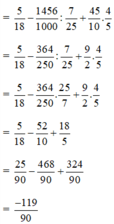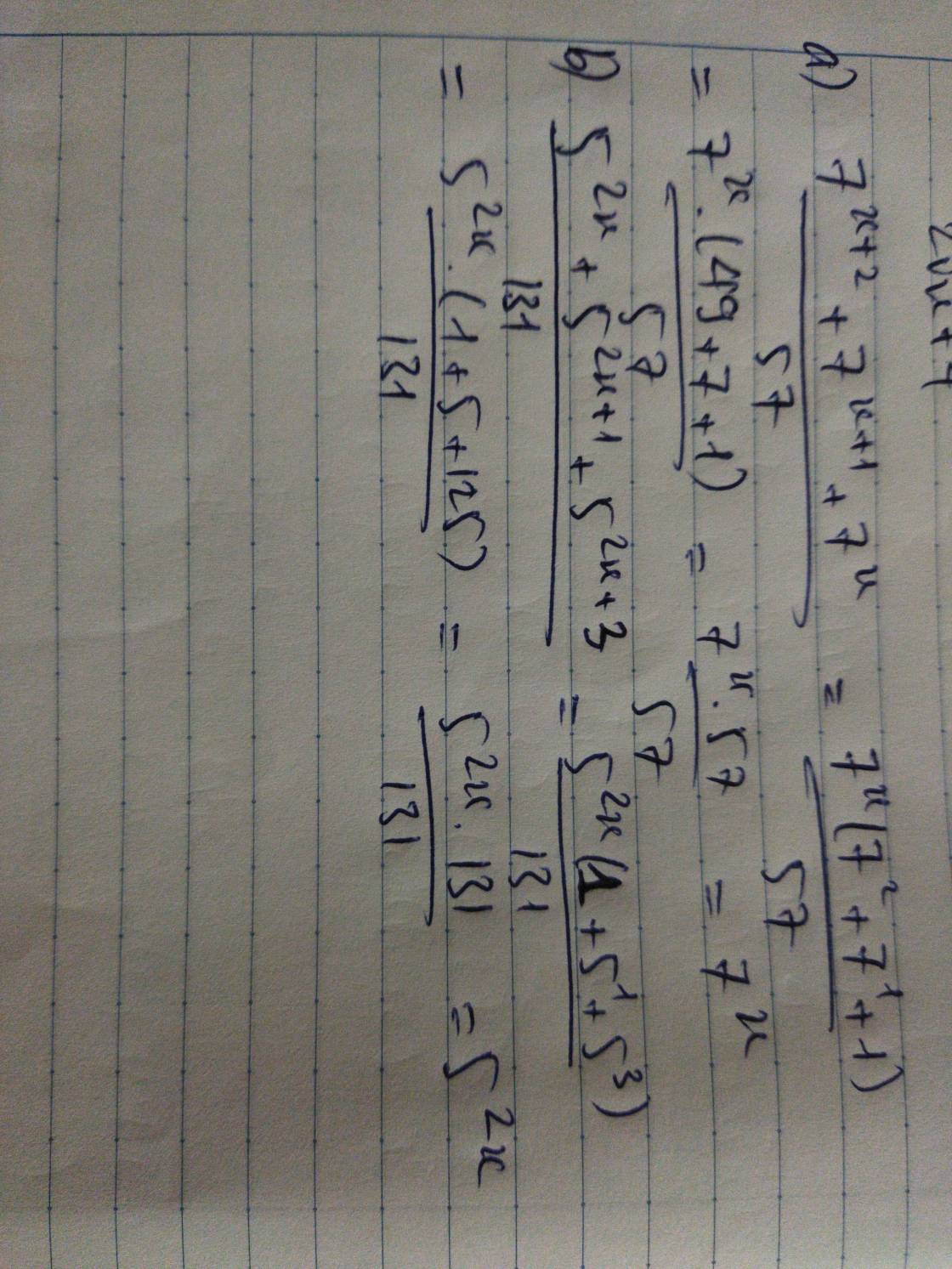
Hãy nhập câu hỏi của bạn vào đây, nếu là tài khoản VIP, bạn sẽ được ưu tiên trả lời.


\(\dfrac{3}{4}-\left[\left(-\dfrac{3}{5}\right)-\left(\dfrac{1}{12}+\dfrac{2}{4}\right)\right]\\ =\dfrac{3}{4}-\left[\left(-\dfrac{3}{5}\right)-\left(\dfrac{1}{12}+\dfrac{6}{12}\right)\right]\\ =\dfrac{3}{4}-\left[\left(-\dfrac{3}{5}\right)-\dfrac{7}{12}\right]\\ =\dfrac{3}{4}-\left[\left(-\dfrac{36}{60}\right)-\dfrac{35}{60}\right]\\ =\dfrac{3}{4}-\left(-\dfrac{71}{60}\right)\\ =\dfrac{3}{4}+\dfrac{71}{60}\\ =\dfrac{35}{60}+\dfrac{71}{60}\\ =\dfrac{106}{60}\\ =\dfrac{53}{30}\)
__
\(-\dfrac{6}{7}.\dfrac{21}{12}\\ =-\dfrac{126}{84}\\ =-\dfrac{63}{42}\\ =-\dfrac{31}{14}\)
__
\(\left(-5\right).\left(-\dfrac{6}{20}\right)\\ =\dfrac{\left(-5\right).\left(-6\right)}{20}\\ =\dfrac{30}{20}\\ =\dfrac{3}{2}\)
__________

3x-1+5.3x-1=162
=>3x-1.6=162
=>3x-1=162:6
=>3x-1=27=33
=>x-1=3
=>x=4

Ta có:
\( \dfrac{7256.4375-725}{3650+4375.7255}\\ =\dfrac{7255.4375+4375-7255}{3650+4375.7255}\\ =\dfrac{7255.4375+\left(4375-725\right)}{3650+4375.7255}\\ =\dfrac{7255.4375+3650}{3650+4375.7255}\\ =1\)
Vậy giá trị của \(\dfrac{7256.4375-725}{3650+4375.7255}=1\)

19/57 . 2 4/7 - 19/57 . 1 5/7 - 19/57
= 19/57 x ( 2 4/7 - 1 5/7 )
= 19/57 x 6/7
= 2/7
\(\dfrac{19}{57}.2\dfrac{4}{7}-\dfrac{19}{57}.1\dfrac{5}{7}-\dfrac{19}{57}\)
\(\text{=}\dfrac{19}{57}.\left(2\dfrac{4}{7}-1\dfrac{5}{7}-1\right)\)
\(\text{=}\dfrac{19}{57}.\left(\dfrac{-1}{7}\right)\)
\(\text{=}\dfrac{-1}{21}\)

a) \(\dfrac{11}{2}=\dfrac{10+1}{2}=5+\dfrac{1}{2}\)
\(\dfrac{32}{9}=\dfrac{27+5}{9}=3+\dfrac{5}{9}< 5+\dfrac{1}{2}\)
Vậy \(\dfrac{11}{2}>\dfrac{32}{9}\)
b)\(\dfrac{100}{23}=\dfrac{92+8}{23}=4+\dfrac{8}{23}\)
\(\dfrac{302}{123}=\dfrac{246+56}{123}=2+\dfrac{56}{123}< 4+\dfrac{8}{23}\)
Vậy \(\dfrac{100}{23}>\dfrac{302}{123}\)
c) \(\dfrac{515}{605}< \dfrac{515+1}{605+1}=\dfrac{516}{606}\Rightarrow\dfrac{515}{605}< \dfrac{516}{606}\)

Ta có: 39 = 3. 13 có ước nguyên tố là 13 khác 2 và 5 nên 5/39 có thể viết được dưới dạng số thập phân vô hạn tuần hoàn
Chọn đáp án A

a) \(\left|x-1\right|+\left|x+3\right|=4\left(1\right)\)
+) TH1: Nếu \(x< -3\) thì \(x-1< 0;x+3< 0\)
\(\Rightarrow\left|x-1\right|=-x+1;\left|x+3\right|=-x-3\)
PT (1) trở thành: \(-x+1-x-3=4\)
\(\Leftrightarrow-2x=6\Leftrightarrow x=-3\left(loại\right)\)
+) TH2: Nếu \(-3\le x< 1\) thì \(x-1< 0;x+3>0\)
\(\Rightarrow\left|x-1\right|=-x+1;\left|x+3\right|=x+3\)
PT (1) trở thành: \(-x+1+x+3=4\)
\(\Leftrightarrow0x=0\) (luôn đúng)
Kết hợp với đk ta được: \(\Rightarrow-3\le x< 1\)
+) TH3: Nếu \(x\ge1\) thì \(x-1>0;x+3>0\)
\(\Rightarrow\left|x-1\right|=x-1;\left|x+3\right|=x+3\)
PT (1) trở thành: \(x-1+x+3=4\)
\(\Leftrightarrow2x=2\Leftrightarrow x=1\left(t/m\right)\)
Vậy x nằm trong khoảng \(-3\le x\le1.\)
Mấy bài kia làm tương tự.
2.
\(\left|x+1\right|+\left|x+2\right|+...+\left|x+10\right|=605x\)(1)
Vì các thừa số ở vế phải của (1) đều không âm nên x không âm. Do đó \(\left|x+1\right|+\left|x+2\right|+...+\left|x+10\right|=\left(x+1\right)+\left(x+2\right)+...+\left(x+10\right)\)
\(\Rightarrow\left(x+1\right)+\left(x+2\right)+...+\left(x+10\right)=605x\)
\(\Rightarrow10x+\dfrac{10\left(10+1\right)}{2}=605x\)
\(\Rightarrow55=595x\)
\(\Rightarrow x=\dfrac{55}{595}=\dfrac{11}{119}\)
Vậy x = \(\dfrac{11}{119}\)




57 + 725 + 605 - 5
= 782 + 600
= 1382
57 + 225 + 605 - 5
= 282 + 605 - 5
= 887 - 5
= 882